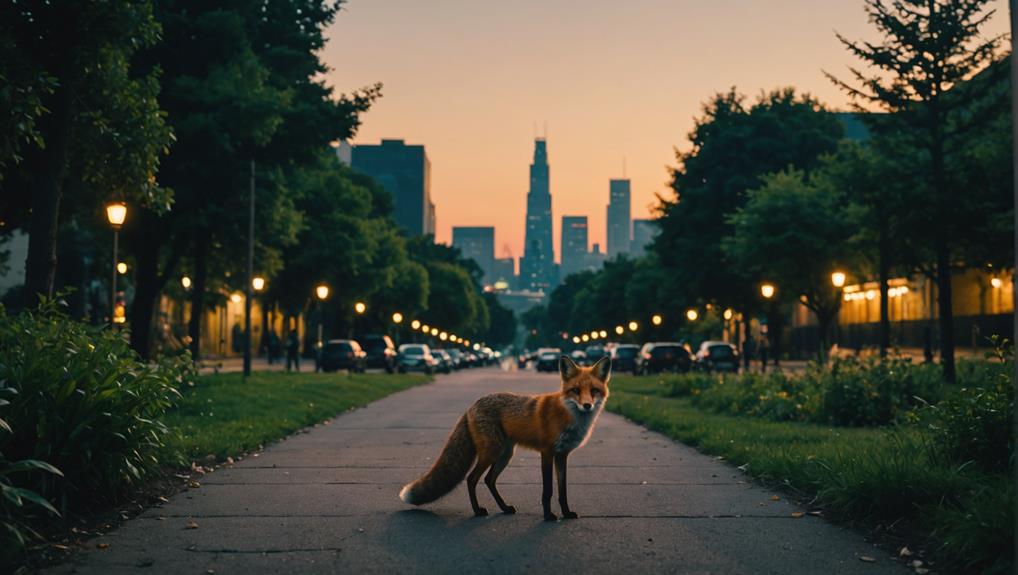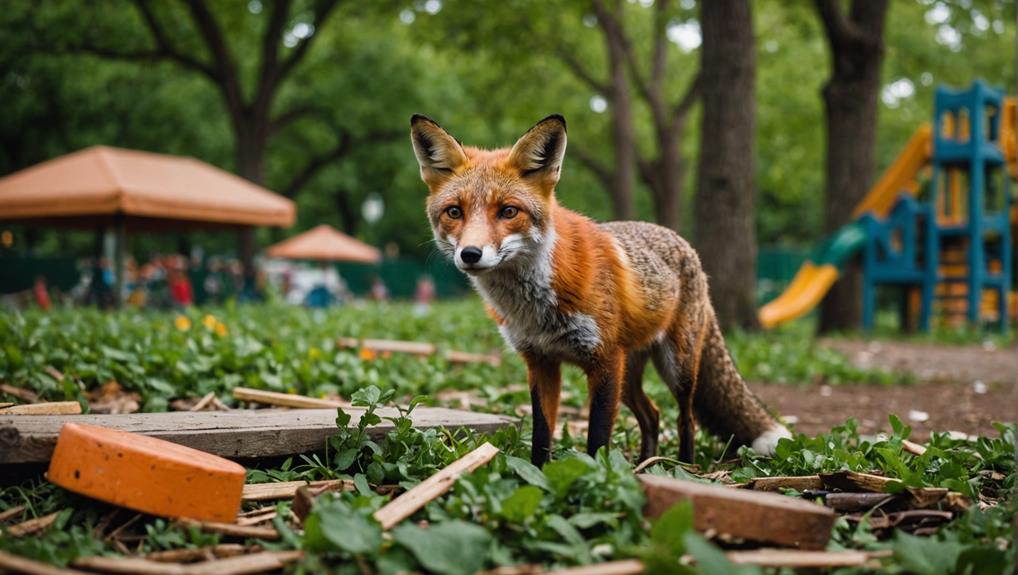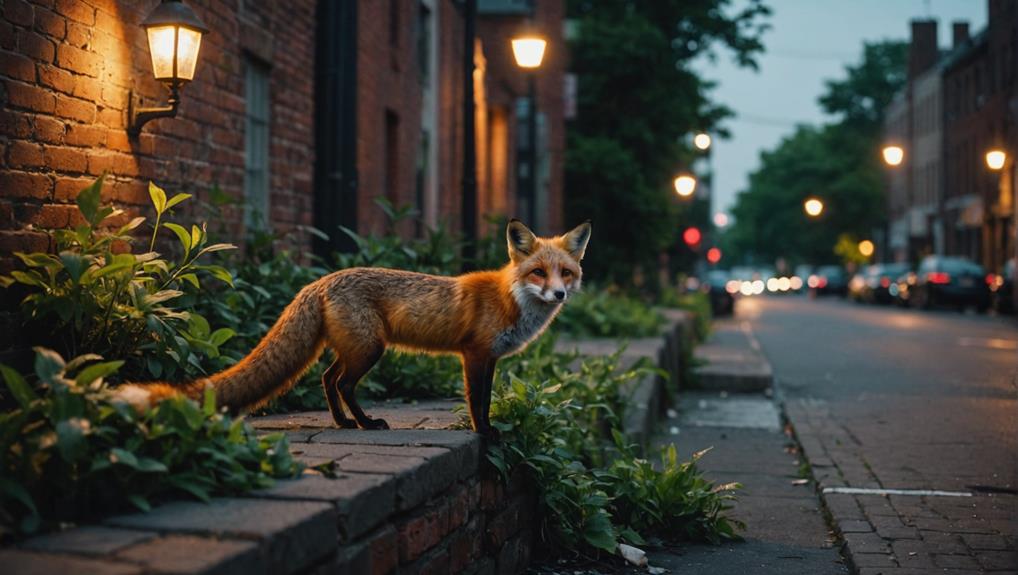Urban foxes, mainly red foxes, are fascinating creatures that have adapted well to city living. You've probably spotted them rummaging through your bins or sunbathing in parks. These clever critters thrive on a diet of small mammals and food scraps—talk about a balanced diet! They make cozy dens under sheds or in bushes, where they raise their adorable cubs. While they usually prefer keeping their distance from humans, they've found ways to coexist with us. Their growing population highlights their resilience. Stick around, and you'll uncover even more captivating details about their lives in urban landscapes!
Contents
Overview of Urban Foxes
Urban foxes, predominantly red foxes (Vulpes vulpes), have become a familiar sight in many UK cities. You might spot one rummaging through your garden or resting lazily in a sunny spot.
These clever creatures have adapted well to urban areas, thriving in habitats like parks and backyards. With a growing community population of around 150,000 by 2017, red foxes show just how resilient they can be!
Their diet is a unique mix of about 50% small mammals and 50% leftover food scraps, proving they can make the best of what urban environments offer. Plus, they've a knack for finding cozy dens under sheds or in bushes, where they raise their adorable cubs.
It's heartwarming to think of them nurturing their young in the midst of busy city life.
However, it's not all fun and games. These urban dwellers face challenges like traffic and health issues. Still, their adaptability shines through as they navigate the complexities of city living.
Adaptation Strategies in Cities
How do red foxes thrive in bustling cities? These clever creatures have a knack for adaptability, which allows them to thrive amidst the chaos of urban life.
You'll often spot urban foxes sneaking through parks or gardens, cleverly foraging for food sources in household refuse or hunting small mammals and birds. They've become masters at finding stable food supplies, especially in suburban areas where they can form small social groups.
Interestingly, red foxes can raise their cubs in urban habitats just as well as in the countryside. Isn't that impressive? Their family units are territorial, ensuring they make the most of their environment.
You might even notice more foxes in cities like London, where their populations can be denser than in rural areas.
What's even more fascinating is how these urban foxes move seamlessly between cityscapes and rural landscapes. This behavior helps maintain their genetic diversity through occasional breeding with their rural counterparts.
In essence, red foxes aren't just surviving; they're thriving, showing us that with a little adaptability, we can all find our place in the world, no matter how busy it gets!
Characteristics of Urban Habitats

When you think about urban foxes, consider where they choose to hang out.
These clever critters find cozy spots under sheds or in dense bushes, making the most of their city surroundings.
Plus, with so many tasty morsels from our leftovers just a paw's reach away, it's no wonder they're thriving in our neighborhoods!
Urban Shelter Locations
In city landscapes, urban foxes find refuge in various shelter locations that cater to their needs. These clever critters, often recognized by their rusty red coats and bushy tails, are experts at making themselves at home in our bustling environments. You might spot them nestled under sheds, hiding in bushes, or even cozying up among tree roots.
These spots serve as perfect shelters for resting and raising their adorable cubs.
Since the 1930s, urban areas have become essential habitats for foxes, with their populations steadily increasing. Their remarkable adaptability allows red foxes to thrive in diverse urban settings, from parks to gardens and residential neighborhoods.
They establish territories that balance their need for food with safe denning sites, proving they can cohabitate alongside us humans quite well.
Food Availability Factors
Urban foxes thrive in city environments largely due to the abundance of food sources available to them. You might be surprised to learn that around 50% of their diet consists of household refuse! These clever creatures have found ways to rummage through gardens, dumpsters, and parks, turning urban habitats into their personal buffet.
But it's not just trash that keeps them well-fed. Small mammals like rodents and birds, as well as seasonal fruits, also form a significant part of their diet. This combination of food availability allows urban foxes to adapt quickly to their surroundings. However, when they rely too much on secured food scraps, it can lead to fluctuations in their populations, making them dependent on our leftovers instead of natural prey.
Luckily, urban habitats provide plenty of shelter through dense shrubs and gardens. These cozy spots allow foxes to establish territories and raise cubs safely near their food sources.
As urbanization reduces rural habitats, it's clear that cities can offer a viable alternative for these resourceful animals, meeting their dietary needs while reminding us how intertwined our lives really are!
Behavioral Patterns of Urban Foxes
When you think about urban foxes, it's fascinating how they've adapted their behavior to thrive in the city.
They're mostly night owls, sneaking around to forage for food while avoiding humans, but you might catch a glimpse of them during the day in quieter spots.
Plus, their social lives are just as intriguing, with vocalizations and group dynamics that show us they're not just solo adventurers—they're more like furry little neighbors with a knack for teamwork!
Foraging and Feeding Habits
Foraging at night, urban foxes demonstrate remarkable adaptability in their feeding habits. These clever creatures have an omnivorous diet, which means they enjoy about 50% meat and 50% household refuse. Talk about being resourceful! They primarily roam the streets under the cover of darkness, displaying nocturnal behavior that helps them avoid humans.
You might find them scavenging through bins or exploring gardens for tasty scraps.
Their strong stomachs allow them to munch on even the most questionable leftovers, making them the ultimate urban cleanup crew. Plus, they play an essential role in controlling rodent populations by feasting on small mammals like mice and birds. Who knew these furry friends were such helpful hunters?
As urban environments expand, the distribution of urban foxes has skyrocketed, increasing from 33,000 in 1995 to around 150,000 by 2017 in the UK. This growth reflects their incredible adaptability to city life.
Vocalizations and Communication
Foxes are surprisingly vocal creatures, showcasing a range of sounds like barks, whines, and throaty calls to communicate with one another. These vocalizations play a vital role in their lives, helping them establish territory and alert others to potential dangers.
You might hear them yipping and calling, especially during the breeding season, when males and females amp up their vocal activity with enticing mating calls. It's like their version of a romantic serenade!
Urban foxes are incredibly adaptive, using their voices to navigate the bustling city life around them. Their social interactions can sometimes get a bit heated—especially when they encounter other fox groups.
You'll notice aggressive vocalizations as they defend their territory, reminding others that they're not to be messed with.
Interestingly, studies show that the complexity of these sounds can change based on environmental factors and population density. This adaptability helps urban foxes thrive in various settings.
Social Structure and Groups
The social structure of urban foxes is fascinating, as it reveals how these clever animals adapt to city life. Typically, they form social groups of two to six adults, creating a little community right under our noses!
While they forage independently, they maintain strong connections through vocal communication, like barks, whines, and howls. These sounds not only reinforce their social bonds but also help establish their territories.
In these groups, you'll often find dominant pairs leading the charge, while subordinate adults assist in raising young cubs. It's like a furry version of teamwork!
Territorial behavior is a big deal for urban foxes; they mark their boundaries to let other foxes know, "Hey, this is my turf!"
Their activity patterns shift in urban settings, making them primarily nocturnal to dodge human encounters. So, if you spot one scurrying by at night, know that it's just a clever fox going about its business.
With their unique social dynamics, urban foxes remind us of the beauty of nature, even in our bustling cities. They're not just surviving; they're thriving!
Human Interaction With Foxes

Urban foxes have become a common sight in many cities, leading to a range of interactions with residents.
These clever creatures have adapted to urban landscapes, thriving in gardens, parks, and streets where food sources like household refuse and small mammals are abundant. You might find yourself having an encounter with a fox rummaging through your trash or basking in the afternoon sun. While these moments can be delightful, they also come with responsibilities.
By securing your food waste and closing potential entry points to your home, you can help foster a peaceful coexistence. Public awareness campaigns encourage folks to report injured or distressed foxes to organizations like the RSPCA, promoting responsible human interaction with urban wildlife.
Community education is essential in highlighting the importance of these animals in maintaining local biodiversity.
Embracing the presence of urban foxes can be a rewarding experience, allowing you to appreciate their unique place in our cities.
Just remember, a little respect and understanding go a long way. So, the next time you see a fox, think of it as your urban neighbor, and maybe even share a smile!
Conservation of Urban Fox Populations
As urban fox populations thrive, conservation efforts are becoming increasingly important to ensure their sustainability in rapidly changing environments.
With the rise in population densities, particularly in cities like London, we need to step up our game.
Here are some ways you can help:
- Support local wildlife organizations that monitor habitats and fox populations.
- Educate your community about securing food waste to reduce human-fox conflicts.
- Promote the creation of wildlife corridors to help foxes safely navigate urban areas.
- Report injured or sick foxes to your local council to ensure they receive proper care.
Final Thoughts
So, there you have it! Urban foxes are fascinating creatures that've learned to thrive right alongside us. By understanding their habits and habitats, we can appreciate their cleverness and resilience. Remember, these little guys aren't just pests; they're a vital part of our urban ecosystem. Let's work together to protect them while enjoying the quirky moments they bring to our lives. After all, who wouldn't smile at a fox sneaking through the park?














